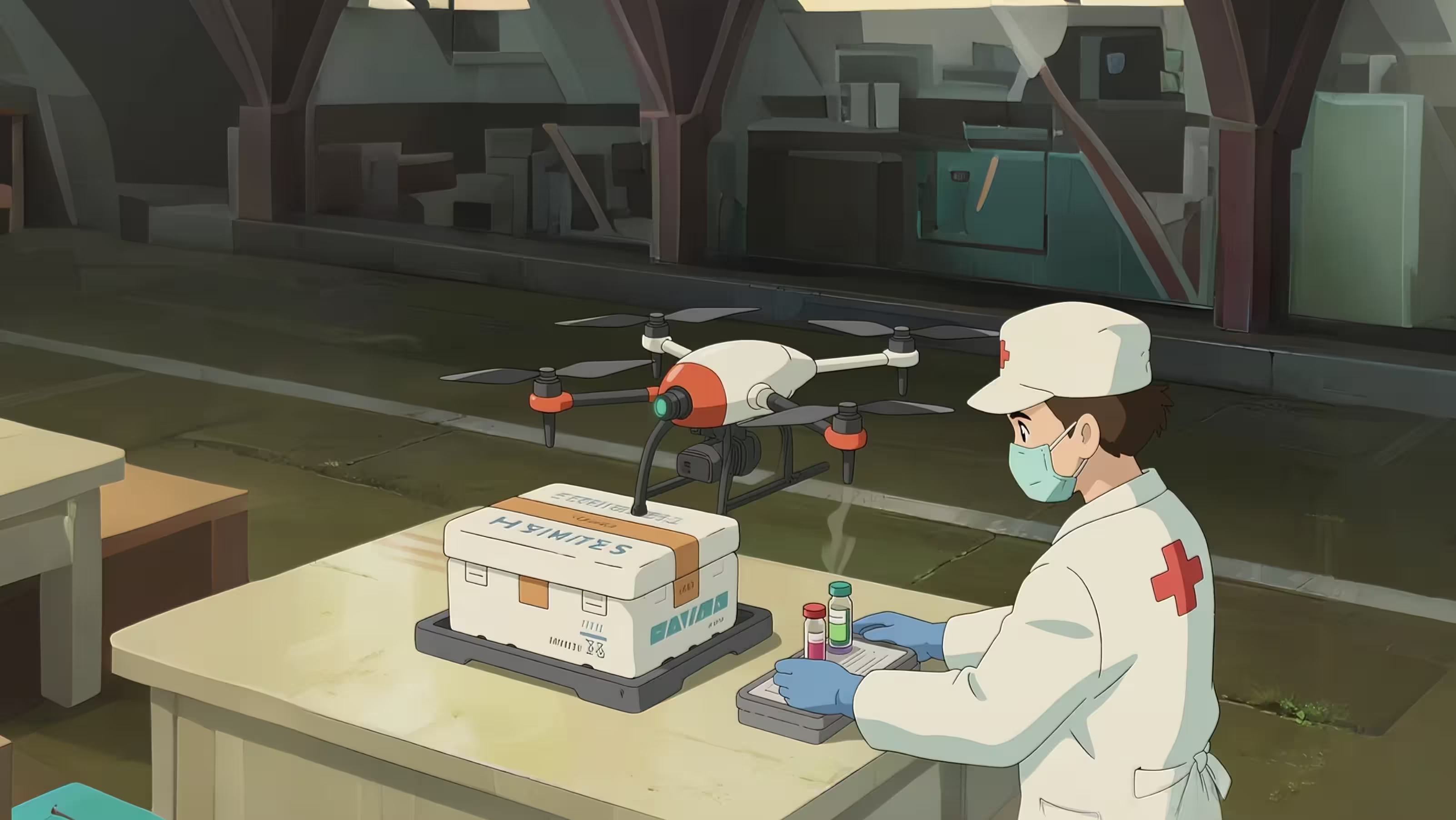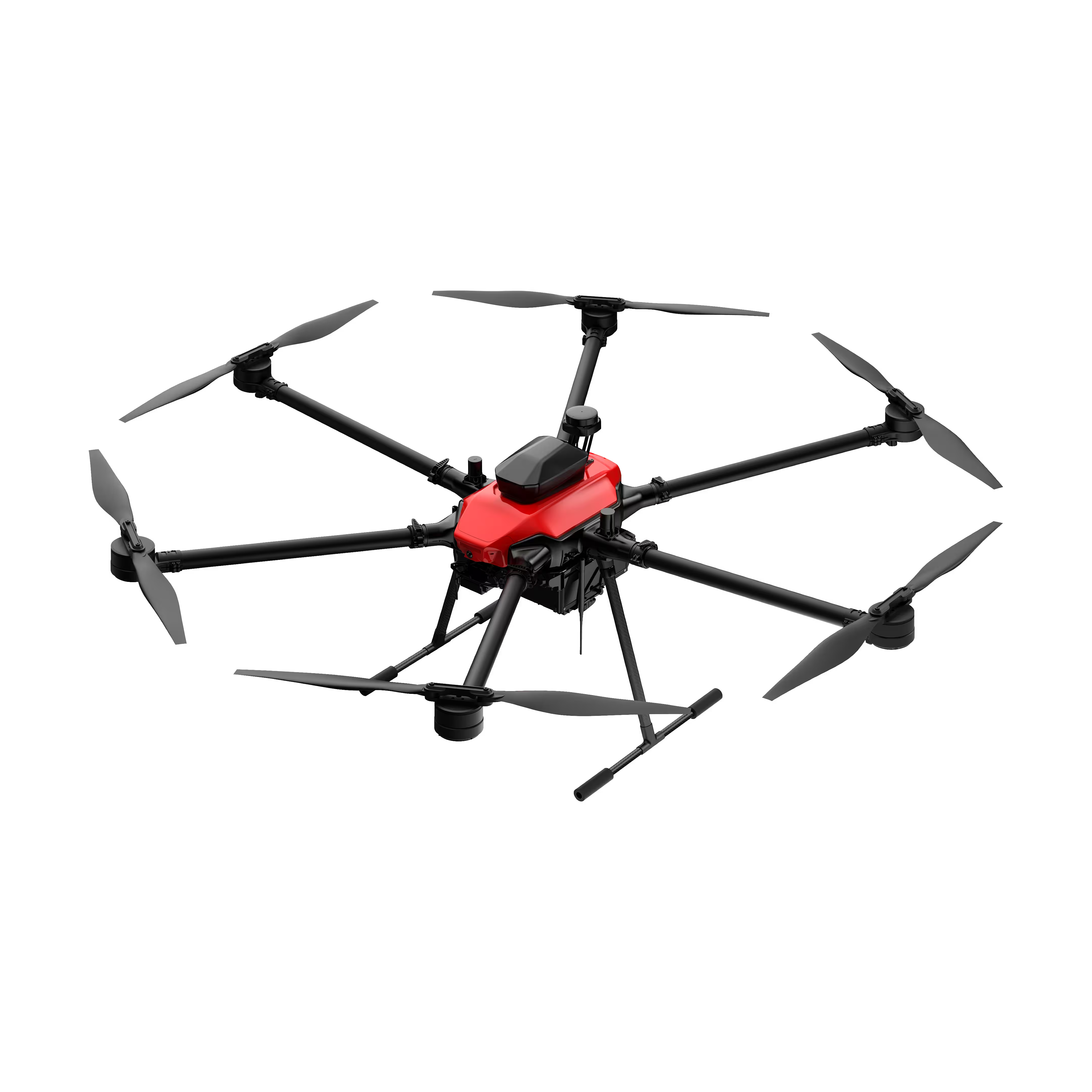Vaccine Cold Chain Delivery
MMC's drone solutions for vaccine cold chain delivery enable remote area coverage via flexible access, multi-temperature zone control through compatible cold chain equipment, and cost-effective high-frequency autonomous delivery with reduced operational costs.
Painpoints
- – Scattered distribution points in rural areas/pastoral regions, where cold chain vehicles struggle to reach, resulting in many coverage gaps.
- – Vaccines require multi-temperature zone control (-20°C ~ 8°C), but equipment compatibility is insufficient.
- – Small delivery volume but high frequency, leading to low cost-effectiveness of manual delivery.
Advantages
- Lightweight design + short takeoff and landing capability: Can take off and land in village open spaces, covering areas inaccessible to traditional cold chain vehicles.
- Unified mounting interface: Compatible with multi-temperature cold chain boxes (-20°C / 2-8°C dual-mode), meeting storage needs of different vaccines.
- Supports hangar scheduled tasks: Enables unmanned autonomous flight, reducing monthly operating costs by 60% compared to manual delivery.
Solution

Remote Area Coverage for Scattered Distribution Points
Skylle Ⅱ addresses coverage gaps in rural/pastoral regions by enabling flexible access to remote, scattered vaccine distribution points.
- Lightweight design combined with short takeoff and landing capability, allowing operations in village open spaces.
- Covers areas inaccessible to traditional cold chain vehicles, eliminating coverage gaps in remote vaccine cold chain delivery.
Drone Platform

Skylle Ⅱ
Hexacopter Industrial Heavy-Lift Drone - 10kg Payload | 60min Flight Time | RTK cm-Level Positioning | IP54 Rated Read More
Learn MorePayload And Software
Bridging Coverage Gaps in Remote Vaccine Cold Chain Delivery: Skylle Ⅱ’s Access to Scattered Distribution Points
In vaccine cold chain delivery, rural and pastoral regions present unique logistical hurdles, primarily stemming from scattered distribution points that lie beyond the reach of traditional cold chain vehicles. These areas, characterized by sparse populations and underdeveloped road infrastructure, often face "coverage gaps"—interruptions in the cold chain where vaccines fail to reach remote clinics, village health stations, or pastoral settlements. For vaccine cold chain delivery, such gaps are critical: they delay immunization campaigns, compromise vaccine efficacy due to temperature excursions during manual transport, and leave vulnerable communities underserved. Addressing these scattered distribution points is thus a cornerstone of equitable vaccine cold chain delivery, and Skylle Ⅱ emerges as a transformative solution by prioritizing flexible access and operational adaptability.
Central to Skylle Ⅱ’s effectiveness in remote vaccine cold chain delivery is its lightweight design paired with short takeoff and landing (STOL) capability. Unlike bulky cold chain trucks that require paved roads or large loading areas, Skylle Ⅱ’s compact frame and low weight enable it to operate in village open spaces, unpaved fields, or even small cleared areas near distribution points. This agility is game-changing for vaccine cold chain delivery in regions where infrastructure is limited: a village square, a pastoral grazing land, or a schoolyard can serve as a temporary takeoff and landing site, eliminating the need for specialized runways. For scattered distribution points, this means vaccines can be transported directly from regional hubs to the doorstep of remote health facilities, reducing reliance on error-prone manual relay systems and ensuring the cold chain remains unbroken in vaccine cold chain delivery.
Beyond operational flexibility, Skylle Ⅱ directly addresses the core challenge of coverage gaps in remote vaccine cold chain delivery by reaching areas inaccessible to traditional vehicles. Mountainous terrain, narrow village lanes, or seasonal flooding often render roads impassable for trucks, creating dead zones in vaccine distribution. Skylle Ⅱ bypasses these barriers, leveraging its STOL capability to navigate challenging landscapes and deliver vaccines to even the most isolated settlements. By covering these previously unreachable areas, it eliminates coverage gaps—ensuring that every scattered distribution point in rural or pastoral regions is integrated into the broader vaccine cold chain delivery network. This not only accelerates immunization timelines but also guarantees that vaccines remain within the required temperature range (-20°C ~ 8°C) from hub to point-of-care, preserving their potency for the communities that need them most.
In summary, Skylle Ⅱ redefines remote vaccine cold chain delivery by turning scattered distribution points from logistical challenges into accessible destinations. Through its lightweight design, short takeoff and landing capability, and ability to cover areas unreachable by traditional cold chain vehicles, it ensures no community is left behind in vaccine cold chain delivery. By eliminating coverage gaps, Skylle Ⅱ strengthens the resilience of vaccine cold chain systems in rural and pastoral regions, making equitable and timely immunization a reality for all.

Multi-Temperature Zone Control for Diverse Vaccine Storage Needs
Skylle Ⅱ ensures precise temperature management for vaccines requiring -20°C ~ 8°C storage through compatible, versatile cold chain equipment.
- Equipped with a unified mounting interface, compatible with multi-temperature cold chain boxes (-20°C / 2-8°C dual-mode).
- Meets storage requirements of different vaccines, resolving equipment incompatibility issues in vaccine cold chain delivery.
Drone Platform

Skylle Ⅱ
Hexacopter Industrial Heavy-Lift Drone - 10kg Payload | 60min Flight Time | RTK cm-Level Positioning | IP54 Rated Read More
Learn MorePayload And Software
Precision Temperature Management for Diverse Vaccines: Skylle Ⅱ’s Multi-Zone Cold Chain Compatibility in Vaccine Delivery
Vaccine cold chain delivery demands stringent temperature control, as different vaccines require distinct storage conditions—ranging from -20°C for frozen vaccines (e.g., some mRNA vaccines) to 2-8°C for refrigerated ones (e.g., traditional inactivated vaccines). This diversity creates a critical challenge: traditional cold chain equipment often lacks compatibility with multi-temperature storage, forcing logistics providers to use separate systems for different vaccines. Such fragmentation increases operational complexity, raises the risk of temperature excursions, and limits the efficiency of delivering mixed vaccine batches to remote or resource-constrained areas. For vaccine cold chain delivery, solving this equipment incompatibility is essential to ensuring all vaccines reach their destinations potent and effective. Skylle Ⅱ addresses this need through its design focused on versatile, precise temperature management.
At the core of Skylle Ⅱ’s capability to handle diverse vaccine storage needs is its unified mounting interface, a feature engineered to integrate seamlessly with multi-temperature cold chain boxes. Unlike conventional drones with fixed or proprietary interfaces that restrict equipment compatibility, Skylle Ⅱ’s standardized mounting system supports dual-mode cold chain containers optimized for both -20°C (frozen) and 2-8°C (refrigerated) storage. This adaptability is transformative for vaccine cold chain delivery: a single drone can now carry multiple vaccine types in separate, temperature-controlled compartments, eliminating the need for fleets of specialized drones or manual sorting. For example, a delivery to a rural health clinic might include frozen vaccines for pediatric immunization and refrigerated ones for maternal health—all transported in a single flight, with each compartment maintaining its required temperature range via integrated cooling systems. This unified interface thus streamlines logistics, reducing the number of flights and minimizing the risk of human error in handling separate cold chain units.
By enabling compatibility with multi-temperature cold chain boxes, Skylle Ⅱ directly resolves the equipment incompatibility issues that have long plagued vaccine cold chain delivery. Traditional setups often rely on rigid, single-temperature containers, forcing providers to choose between prioritizing one vaccine type or incurring higher costs for multiple delivery runs. Skylle Ⅱ’s design flips this paradigm: its versatile interface ensures that diverse vaccines—whether requiring deep freezing or refrigeration—can be transported in a single mission, each with precise temperature maintenance. This not only meets the storage requirements of different vaccines but also enhances the flexibility of vaccine cold chain delivery networks. Health authorities can now optimize routes, consolidate shipments, and ensure that even small, mixed batches of vaccines reach scattered distribution points without compromising temperature integrity. For communities dependent on timely access to a range of vaccines, this means more reliable immunization campaigns and reduced waste from temperature-related vaccine spoilage.
In summary, Skylle Ⅱ redefines temperature management in vaccine cold chain delivery by merging precision with versatility. Through its unified mounting interface and compatibility with dual-mode (-20°C / 2-8°C) cold chain boxes, it ensures that diverse vaccine storage needs are met in a single, efficient delivery. By resolving equipment incompatibility, Skylle Ⅱ not only simplifies logistics but also guarantees that every vaccine—regardless of its temperature requirement—remains potent from hub to point-of-care, strengthening the resilience of global vaccine cold chain systems.

Cost-Effective High-Frequency Delivery with Autonomous Operations
Skylle Ⅱ reduces operational costs for small-volume, high-frequency vaccine cold chain delivery through unmanned, scheduled autonomous flights.
- Supports hangar-based scheduled tasks, enabling unattended autonomous flight for consistent, frequent deliveries.
- Lowers monthly operating costs by 60% compared to manual delivery, improving cost-effectiveness in high-frequency vaccine cold chain delivery scenarios.
Drone Platform

Skylle Ⅱ
Hexacopter Industrial Heavy-Lift Drone - 10kg Payload | 60min Flight Time | RTK cm-Level Positioning | IP54 Rated Read More
Learn MorePayload And Software
Autonomous Scheduling for Cost-Effective High-Frequency Vaccine Cold Chain Delivery
High-frequency, small-volume vaccine cold chain delivery is critical for maintaining consistent stock levels at remote clinics or addressing urgent immunization needs, yet it often faces challenges like high operational costs from manual labor and logistical inefficiencies. Traditional delivery methods rely on human operators for flight control, vehicle maintenance, and route coordination, driving up labor expenses and limiting scalability for daily or weekly small-batch shipments. For vaccine cold chain delivery, this inefficiency can delay access to time-sensitive vaccines or strain budgets in resource-constrained regions. Skylle Ⅱ resolves these issues by leveraging unmanned, scheduled autonomous operations to streamline high-frequency delivery while significantly reducing costs.
At the core of Skylle Ⅱ’s capability for cost-effective high-frequency delivery is its support for hangar-based scheduled tasks, enabling fully unattended autonomous flight. Unlike manual drone operations that require on-site pilots and pre-flight checks, Skylle Ⅱ integrates with automated hangar systems to execute pre-programmed delivery routes without human intervention. The hangar handles battery swapping, system diagnostics, and takeoff/landing procedures, allowing the drone to complete multiple daily missions—such as morning and afternoon deliveries to scattered rural clinics—with minimal oversight. This autonomy eliminates labor costs associated with pilot staffing and reduces downtime between flights, ensuring consistent, frequent delivery cadences that align with vaccine restocking schedules. For example, a regional health hub could program Skylle Ⅱ to deliver 5-10 doses of refrigerated vaccines to three remote villages daily, with the drone self-launching, navigating pre-approved routes, and returning to the hangar for recharging—all without manual input.
The key outcome of this autonomous, scheduled operation is a 60% reduction in monthly operating costs compared to manual delivery methods. Traditional manual delivery involves expenses like pilot salaries, fuel for ground transportation, and maintenance for vehicles, which escalate with frequent small-volume shipments. Skylle Ⅱ minimizes these variable costs by replacing human-operated flights or truck deliveries with unmanned, hangar-managed missions, optimizing resource use (e.g., battery life, flight routes) and reducing reliance on manual labor. This cost efficiency is particularly impactful for high-frequency scenarios, where small-volume shipments (e.g., weekly vaccine restocks for rural health posts) would otherwise be economically unfeasible with traditional logistics. For instance, a monthly manual delivery route serving five remote clinics might cost $5,000; with Skylle Ⅱ’s autonomous system, this cost drops to $2,000, freeing budgets for additional vaccines or expanded coverage.
In summary, Skylle Ⅱ transforms high-frequency vaccine cold chain delivery from a costly, labor-intensive process into an efficient, scalable operation. Through hangar-based scheduled tasks and unattended autonomous flight, it ensures consistent, frequent deliveries while cutting monthly operating costs by 60%. This combination of autonomy and cost reduction enhances the cost-effectiveness of high-frequency vaccine cold chain delivery, ensuring remote and underserved communities receive timely access to life-saving vaccines.